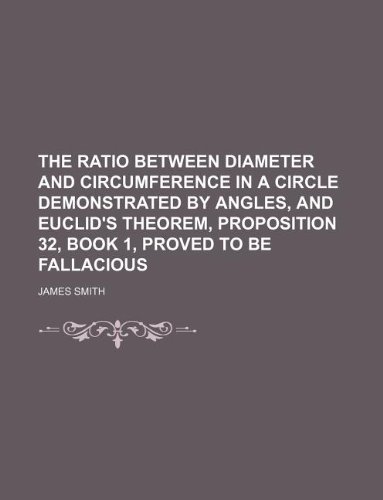James Smith
The ratio between diameter and circumference in a circle demonstrated by angles, and Euclid's theorem, proposition 32, book 1, proved to be fallacious
Paperback
(RareBooksClub.com March 6, 2012)
This historic book may have numerous typos and missing text. Purchasers can download a free scanned copy of the original book (without typos) from the publisher. Not indexed. Not illustrated. 1870 Excerpt: ...will be equal to four right angles. In either case the angles at the centre of the circle will be equal to the arcs by which they are subtended. Hence: Euclid's 19th definition is positively fallacious. J. Radford Young, a living "recognised Mathematician" saw this, for, in his "Elements of Euclid" he observes:--" The term polygon, however, is often employed as a general name for rectilineal figures of all kinds, without regard to the number of sides; so that the rectilineal figures defined above (definitions XVII. and XVIII.), may, without impropriety, be called polygons of three and of four sides respectively." This brings to light some remarkable facts, with reference to Mathematics as applied to Geometry. If a regular polygon of any number of sides greater than 4 be inscribed in a circle, the ratio between the sides of the polygon and their subtending arcs is constant, and-expresses this ratio, whatever be the value of It; but this ratio does not hold good for a polygon of 3 or of 4 sides inscribed in a circle. But, if the circumference of a circle be divided into any number of equal arcs, and from one of these arcs T'sth part be deducted, and the remainder be multiplied by the sum of the arcs, the product is constant, and equal to the perimeter of a regular hexagon or six-sided polygon inscribed in the circle: and this is true, whether the inscribed polygon to the circle, be a polygon of 3 sides or of 4 sides, or of any other number of sides. Any one conversant with the simple rules of arithmetic "can follow out and test this." Geometry is an exact science, and Geometers by excluding arithmetical considerations from their study of Geometry, are led into all sorts of blunders; and I am glad to find, that "rec...
- ISBN
- 1130035913 / 9781130035919
- Pages
- 150
- Weight
- 9.9 oz.
- Dimensions
- 7.4 x 0.3 in.
Enjoy reading The ratio between diameter and circumference in a circle demonstrated by angles, and Euclid's theorem, proposition 32, book 1, proved to be fallacious? You may also like these books
-

Mr James Smith
How To Remember Chemistry, Programming Languages, Acronyms Or Shorthand, Letter & Number Combinations, Number & Other Tables, Latin & Greek Roots, ... Basic Synthesizer & Guitar Playing & More
Paperback (CreateSpace Independent Publishing Platform July 19, 2017) -
Q

D. James Smith
Probably the World's Best Story About a Dog and the Girl Who Loved Me
Hardcover (Atheneum/Richard Jackson Books Aug. 8, 2006) -

James Smith
Defence: Against No-Trump & Trump Contracts
Paperback (Independently published April 30, 2017) -

Mrs. James Smith
The Booandik Tribe of South Australian Aborigines: A Sketch of Their Habits, Customs, Legends, and Language
Paperback (Forgotten Books April 30, 2017) -

James A. Smith
Life as a Moonshiner's Son: Adversity, danger, occasional humor
Paperback (AuthorHouse Oct. 7, 2009) -

James Smith
Precious Things from the Everlasting Hills - Pleasant Fruits for All People
Paperback (Bottom of the Hill Publishing Sept. 1, 2012) -
O

James Smith
How James Fell Asleep: A Bedtime Story that can Make anyone Fall asleep Fast
Paperback (CreateSpace Independent Publishing Platform Sept. 22, 2015) -
S

D. James Smith
It Was September When We Ran Away the First Time
Hardcover (Atheneum Books for Young Readers Sept. 9, 2008) -

John James Smith
I Wonder If the Shower Dreams of Being a Waterfall Some Day?
Paperback (America Star Books Oct. 12, 2011)











